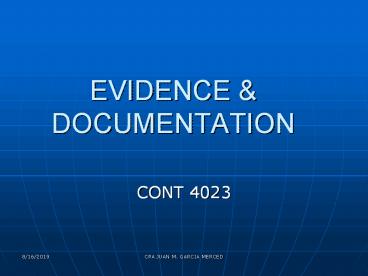EVIDENCE - PowerPoint PPT Presentation
Title:
EVIDENCE
Description:
Reperformance It is the auditor s independent tests of accounting ... preserves working papers that show relatively few or no changes Leases Pension plans ... – PowerPoint PPT presentation
Number of Views:81
Avg rating:3.0/5.0
Title: EVIDENCE
1
EVIDENCE DOCUMENTATION
- CONT 4023
2
Audit Evidence Decisions
1. Which audit procedures to use
2. What sample size to select for a given
procedure
3. Which items to select from the population
4. When to perform the procedures (timing)
3
Audit Plan
It includes a list of the audit procedures the
auditor considers necessary.
- Sample sizes
- Items to select
- Timing of the tests
Most auditors use computers to facilitate the
preparation of audit plans.
4
Audit Documentation
Audit documentation is the principal record of
auditing procedures applied, evidence obtained,
and conclusions reached by the auditor in the
engagement.
5
Audit Documentation
- Purposes of audit documentation
- Ownership of audit files
- Confidentiality of audit files
6
Purpose
- Sufficient competent evidential matter is to be
obtained trough inspection, observation,
inquiries, and confirmations to afford a
reasonable basis for a conclusion.
7
AUDIT EVIDENCE
- Any information that corroborates or refutes an
assertion. Must be - Competent relevant and valid (Quality)
- Sufficient Quantity
- There is an inverse relationship between
competent and sufficiency.
8
Six Characteristics of Reliable Evidence
1. Independence of provider
2. Effectiveness of internal controls
3. Auditors direct knowledge
9
Six Characteristics of Reliable Evidence
4. Qualification of individuals providing the
information
5. Degree of objectivity
6. Timeliness
10
Persuasiveness and Cost
In making decisions about evidence for a given
audit, both persuasiveness and cost must be
considered.
The auditors goal is to obtain a sufficient
amount of appropriate evidence at the lowest
total cost.
11
Competence of Types of Evidence
- Type of evidence
- Independence of provider
- Effectiveness of clients internal controls
- Auditors direct knowledge
- Qualifications of provider
- Objectivity of evidence
12
Types of Audit Evidence
1. Physical examination 2. Confirmation 3.
Documentation 4. Analytical procedures 5.
Inquiries 6. Recalculation 7. Reperformance 8.
Observation
13
TYPES OF EVIDENCE
- Physical evidence- provides evidence about
existence but needs to be supplemented by other
types of evidence.
14
Confirmation
Information
Source
Assets
Cash in bank Accounts receivable Notes
receivable Owned inventory out on
consignment Inventory held in public
warehouses Cash surrender value of life insurance
Bank Customer Maker Consignee Public
warehouse Insurance company
15
Confirmation
Information
Source
Liabilities
Accounts payable Notes payable Advances from
customers Mortgages payable Bonds payable
Creditor Lender Customer Mortgagor Bondholder
16
Confirmation
Information
Source
Owners Equity
Shares outstanding
Registrar and transfer agent
Other Information
Insurance coverage Contingent liabilities Bond
indenture agreements Collateral held by creditors
Insurance company Bank, lender, and clients
legal counsel Bond holder Creditor
17
TYPES OF EVIDENCE
- Documents
- Created outside the company and transmitted
directly to the internal auditors - Created outside the company and held by the
company - Created and held within the company
18
Documentation
It is the auditors inspection of the clients
documents and records.
External documents
Internal documents
19
Analytical Procedures
- Understand the clients industry and business
- Assess the entitys ability to continue as a
- going concern
- Indicate the presence of possible misstatements
- in the financial statements
- Reduce detailed audit tests
20
Inquiries
It is the obtaining of written or oral
information in response to questions from the
auditor.
21
Recalculation
It involves rechecking a sample of
calculations made.
22
Reperformance
It is the auditors independent tests of
accounting procedures or controls that were
originally done.
23
Observation
It is the use of the senses to assess activities.
The auditor may tour the plant to obtain a
general impression of the facilities.
24
AUDIT PROCEDURES
- Timing
- Nature
- Extent
- Cost
25
WORKING PAPERS
- Functions
- Assignment and coordinating audit work
- Supervising and reviewing the work of assistants
- Supporting the report
- Complying with the stds of field work (IIA
standards) - Planning and conducting the next audit
26
OTHER CONSIDERATIONS
- Confidential nature
- Ownership of working papers
27
TYPES OF WORKING PAPERS
- Administrative working papers
- Audit plan
- Time budget
- Internal control documentation
- Working trial balance
- Lead schedules
- Adjusting journal entries
28
Types of Working Papers
- Supporting schedules
- Analysis of a ledger account
- Corroborating documents
29
ORGANIZATION
- Current files one file per year
- Permanent file preserves working papers that
show relatively few or no changes - Leases
- Pension plans
- Labor contracts
- Formal agreements
30
Questions?!?!?!?!?!?!?!?































